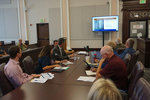




Lewis County commissioners have long bemoaned the decline of timber harvesting on state-managed lands that provide revenues for local governments and taxing districts. Monday, they got to share those concerns with officials from the Washington Department of Natural Resources — but representatives from the agency said not to expect an uptick in timber revenues anytime soon.
“We’re expecting you’ll get more like 17 million board-feet a year (over the next 10 years) instead of 22 (the average for the past eight years),” said Andy Hayes, division manager of the DNR’s Forest Resources Division. “(Lewis County) has more young trees than we have old trees. If we had the same number of old and new every year, we could harvest the same amount every year.”
That age skew works against the county as state leaders focus on preserving old-growth trees and mature forest. However, DNR leaders told the county that it will likely be gaining more operable acres — or lands open to timber harvest — under a new plan to protect the marbled murrelet.
Much of the decline in timber harvests has been to protect endangered species such as the marbled murrelet, a seabird that nests in old-growth forests. Lewis County officials have long lamented that the agency’s current plan to protect the bird has had adverse effects on their budgets.
In Lewis County, DNR oversees 40,000 acres of state forest transfer trust lands. The revenues from timber harvests on those lands benefit the districts in which they are located, including county government, schools, hospitals, fire services, cemeteries and libraries. Under the agency’s current plan to protect the marbled murrelet, roughly half — about 21,000 — of the acres in Lewis County are open for timber harvesting. The new plan likely to be adopted by the end of the year would open up about .3 percent more, about 64 acres.
“Because Lewis County is not a major focus in our strategy, you see a few benefits but you don’t see any decreases,” Hayes said.
County officials seemed relieved that the plan will not further reduce harvesting areas, while others expressed dismay that the new plan — known as Alternative H — will not reopen more forests.
“It sounds like this is good news for Lewis County,” said commissioner Bobby Jackson. “More acres are going to be allowed for harvest.”
Commissioner Edna Fund had a mixed assessment.
“It appears that the marbled murrelet, when we look at the plan, is having minimal impact on us,” she said. “That does not mean that we get more money, because these are potentially harvestable lands. There’s still the issue of not harvesting as much as we’d like.”
Rep. Ed Orcutt, R-Kalama, said that the increase was paltry when compared with the acres that have already been removed from DNR’s harvestable inventory. He pointed out the Pe Ell School District, which will gain a small amount of operable acres on its trust land under the new plan — but not nearly enough for Orcutt.
“Yes, it’s an increase,” he said. “It’s not a huge increase. You’re getting .3 percent back of the 45 percent you lost initially.”
According to the DNR, state trust lands in Lewis County have generated about $6.6 million in revenue so far this year, and they’re expected to bring in $16.6 million total in 2019. Of that $6.6 million, about $1 million has gone to the county’s general fund, with another $1.5 million set aside for roads. The rest is distributed among various taxing districts in the county. Budget Manager Becky Butler said timber revenues can be volatile, and the county has already received more than its conservative budget estimate for the year.
“We budgeted about $800,000 (for the general fund for the year), and we’ve already received more than that,” she said. “That’s one of those unanticipated revenues.”
Commissioners have long encouraged the DNR to consider the effects its conservation decisions have on the budgets of local governments. Commissioner Gary Stamper urged agency officials to consider the county’s limited options for collecting revenue.
“We have taxes and we have timber and we have sales tax. We can’t drop Microsoft in the middle of Lewis County. It’s not going to happen,” he said. “We’re very concerned about the fiduciary responsibility of DNR. A number of people feel DNR’s not meeting those demands. Small fire districts, hospitals, especially in those rural areas, this is what it’s going to impact.”
Hayes acknowledged that the state’s trust lands are set up to benefit local governments, and DNR needs to do a better job of having “honest conversation” with them.
“You’re the shareholders of that business,” he said. “We’re working about getting better at that. It’s probably going to be fits and starts.”
Following the meeting, Orcutt claimed that many of the agency’s protections hurt residents more than they help endangered species.
“You’re having a much larger economic impact than what you’re getting for an ecological benefit,” he said. “Many times you’re getting a huge economic impact with no ecological benefit.”
Fund said she was grateful the state officials made the visit, but she still wants to see more trees cut and more money for county services.
“They’re being more open in getting more input and talking about what their story is and what our story is,” she said. “We’re looking at how do we increase our yield so we can use it in our budget. That’s what I want to get to.”